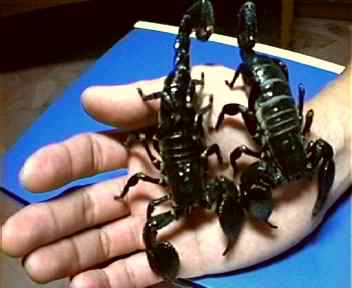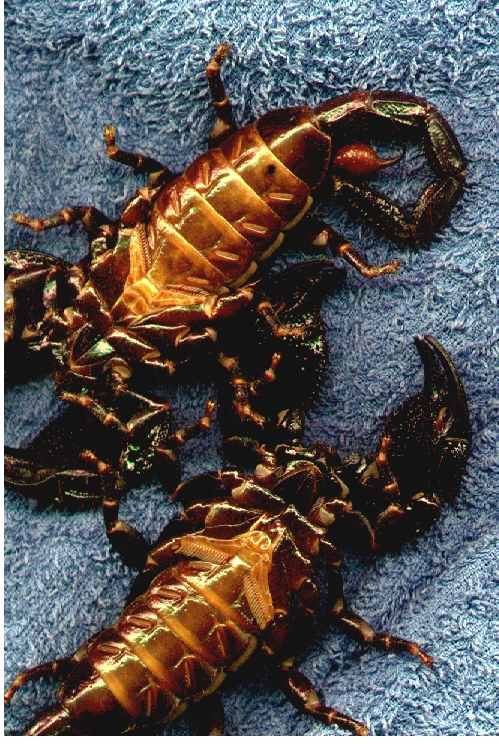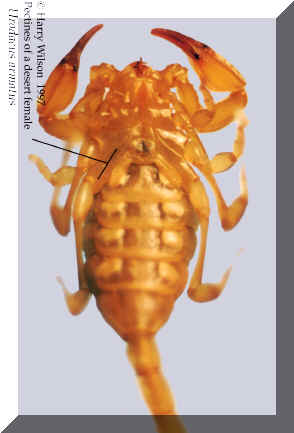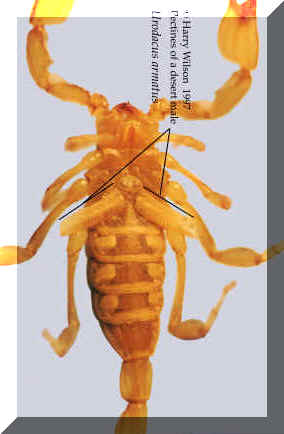
Which is the male and female? This poorly taken
shot of 2 Pandinus imperator illustrate how deceptive
other parameters can be in determining the size.
Put cursor over image to reveal the answer.
How to differentiate the sexes in scorpions
(Sexual dimorphism)
Scorpions are not easy to tell its sex. Short of dissecting your scorpion to look for the primary sexual characteristics or wait till one give birth (to show it's a pregnant female), it is rather difficult for most to tell which is which. Based a number of books, contacts, familiarity with some of the characteristics and internet resources, I have summarised a few of the secondary characteristics.
As understanding of basic morphology is recommended, please go through briefly the anatomy section of the page before reading further.
Secondary sexual characteristics:
On chelae of pedipalp
Heavier crenulation (roughness) on the cutting edge of male scorpion
Possible depression on the manus in male during mating season. Postulated to be used for
holding the female chelae during the mating 'dance'.
Thicker and more prominent ridge like carina in male.
Above characteristics can be observed to some degree in Heterometrus spinifer but
not obvious in Pandinus imperator.
Pedipalp is longer and narrower than female in Heterometrus sp.
Pedipalp is shorter and wider in male of some Tityus sp, Scorpio maurus and some
Buthus sp
Size:
Adult female is relatively longer in carapace length than male. (due to difference in
age, the relative difference have no basis of comparision except in a population pool).
Reveres is true in Tityus trinitatus, Liocheles australasiae
and a few other species.
The ratio between the length of the carapace and sternite VII is
lower in the female. ie the female is also wider. This often not very obvious and
useful for most species.

Which is the male and female? This poorly taken
shot of 2 Pandinus imperator illustrate how deceptive
other parameters can be in determining the size.
Put cursor over image to reveal the answer.
Metasoma/telson:
Adult male generally has a greater metasoma:carapace length ratio. This is due to the
two phase growth of metasoma (faster growth in adult phase) of most males. For female, the
growth of metasoma is almost linear. Especially pronounced in Ischnuridae (eg. Hadogenes
sp.)
Telson is generally larger and more round in female. exceptions include Euscorpius sp and
Anuroctonus sp
Pectens:
Most commonly and easy to use reference point.
Pectens longer in male. However direct measure is not very helpful as pecten length grows
with age and differs with species.
The pecten tip of male goes beyond the distal end of coxa IV
while the tip of female do not reach the distal end of coxa IV.
Pectinal teeth is shorter and straighter in female.
The male generally has more pectinal teeth
Female pectens forms an obtuse angle at the basal piece while that of the male is more
perpendicular. (smaller angle) but this position is highly variable.
Genital operculum
The genital operculum of many Scorpionids shows that it is more oval in male and
slightly triangular in female. In addition, the genital operculum is fused in female and
split in males. The males of most scorpions have a pair of genital papillae protruding
from the posterior margin of the genital operculum when it is lifted open. This is a
sure way of telling a male from a female though it is very very difficult to perform with
live specimens.

Ventral view of 2 Pandinus imperator. The specimen above is a female
while one below is a male. Note the pecten tip of male extend further than the
female and the pectinal fins are longer. Note also the shape of the genital
operculum. There are few other visible differences between them.


Highly illustrative pictures of female (left) and male (right) specimens
of Urodacus armatus kindly provided for use by Dr Harry Wilson.
Notice:
1) Longer pectines of the male
2) More number of pectinal teeth in the male
3) Shorter pectinal teeth of female
4) wider mesosoma width of female
5) slight difference in shape of genital operculum (rhomboidal for female and triangular
for male)
6) distal tip of pectines extends beyond coxa IV for male.
7) The pedipalp of the male is apparently slightly larger though it is not completely
visible.
As for the more obtuse angle of the male, it is against the convention (supposedly female
angle > male) which from what I see is not surprising as in both antemortem and
postmortem, the position can be highly varied and unreliable as a gauge.
It must be noted that not all scorpion species shows such marked sexual dimorphism. Many are very much more subtle
Click here to link to Dr Stockwell's FAQ on sex. It contains pictures which explains things clearer.
Some common misconceptions related to scorpion sex
1) The scorpions mate using their 'tails'.
Fact: Scorpions do not literally have copulation as we commonly perceived.
There is no direct contact between the primary sexual organ which is covered by the
genital operculum. For more about how scorpions mate refer to mating. The telson ,however, may be used by some species
like male Hadogenes sp to sting the female to 'calm' her.
2) The scorpion defecate from the below .......
Fact: Two mistakes are committed here. One scorpions do not really defecate as
they do not take in solid food. The more correct term should therefore be excrete (like in
our urine). Secondly, scorpions excrete not from anywhere but the anus which is at the
distal joint of metasomal V (between metasoma and the telson).
3) Female scorpions show the 'white stuff' between the two hard carapace of the
abdomen
Fact: That white stuff is the pleural membrane which connects the tergite and
the sternite. Pregnant scorpion especially those in late gestation period shows very much
of the pleural membrane due to the stretching. However, overfed scorpions, regardless of
sex, also show much of the pleural membrane. On the other hand, starving non-pregnant
female may show little or no pleural membrane.
4) Males are bigger.
Fact: Most males of most species are in fact shorter and narrower than females.
However, many exceptions exist and in some species, the male are indeed bigger while in
others, there's no significant difference.